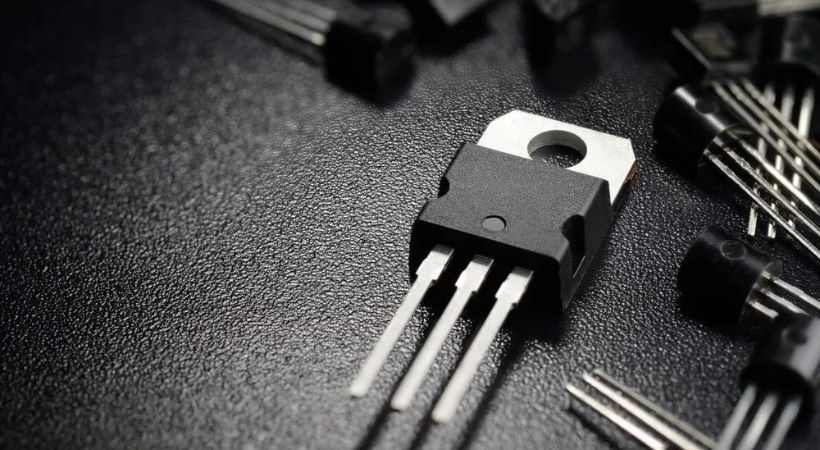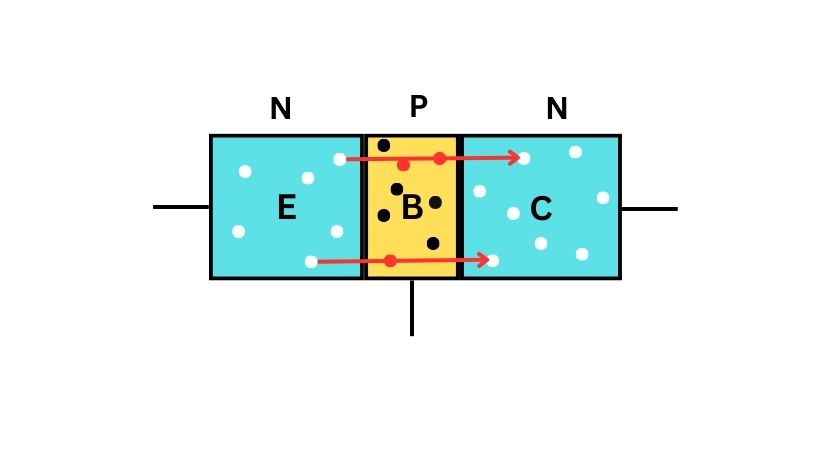To understand the transistors, learning the NPN and PNP transistors is essential for better and more reliable circuit design.
The BJTs are one of the main types of transistors. The NPN and PNP are the two types of bipolar junction transistors (BJTs). These transistors have three layers, emitter, base, and collector. The base is sandwiched between the collector and emitter. The main difference between NPN and PNP is, that in NPN electrons are the majority carriers, and in PNP holes are the majority carriers.
In this article, we delve into the intricacies of NPN and PNP transistors, exploring their structures, operations, applications, and considerations for circuit design.
Transistors
Transistors are fundamental electronic devices that play a crucial role in modern electronics. They were invented in 1947 by John Bardeen, Walter Brattain, and William Shockley at Bell Labs.

Before the invention of transistors, vacuum tubes were used in different devices. They increased the size of the device and were not as efficient as transistors.
The transistor has effectively reduced the size of electronic devices and made them more reliable and accurate. The transistors form the building blocks of integrated circuits (ICs).
A transistor is a semiconductor device that controls current. It is constructed by a chemical process called doping and creates three conducting layers.
A material that has undergone doping may either have holes (P-type), which are vacancies for electrons, or more electrons (N-type). The conducting layers are the emitter, base, and collector.
If you want to learn more about transistors check out our article:
NPN and PNP are the two most common types of bipolar junction transistors (BJTs), which are three-layer semiconductor devices used for amplification and switching of electronic signals.
Let’s discuss NPN and PNP transistors in detail.
NPN transistors
An NPN (Negative-Positive-Negative) transistor is a bipolar junction transistor (BJT). It is one of the basic building blocks in electronic circuits and is commonly used for amplification and switching purposes.
Structure of NPN
An NPN (Negative-Positive-Negative) transistor is a three-layer semiconductor device.
It consists of a thin, lightly doped layer of P-type material sandwiched between two thicker, heavily doped layers of N-type material.

The N-type material forms the emitter and collector regions, while the P-type material forms the base region.
NPN operation
The operation of the NPN transistor is based on the current flow between the emitter and collector by changing the current at the base terminal. There are three layers: emitter, base, and collector.
In NPN, the emitter is made of N-type, the base is made of P-type, and the collector is made of N-type material.

When a small voltage is applied across the emitter-base junction, it forward-biases this junction, allowing electrons to flow from the negatively charged emitter to the positively charged base.
The small fraction of electrons combine with holes in the base because the base is thin and lightly doped. This will create a small base current. All the electrons from the emitter reach the collector, and the collector-base junction is reverse-biased.
As a result, a large current will flow from the emitter to the collector.
The critical aspect of NPN transistor operation is that the base current controls the much larger collector current (Ic), flowing from the collector to the emitter.
NPN transistor has three operating regions: Active region, cut-off region, and saturation region.
In the active region, the emitter-base junction is forward-biased and the collector-base junction is reverse-biased. The transistor acts as an amplifier.
Both the junctions are reverse-biased in the cut-off region and the transistor is in the off state and there will be no current flowing through it.
On the other hand, the off of the transistor is the saturation region. Both junctions are reverse-biased in the saturation region and have high current flow through the transistor.
NPN transistors applications
NPN (Negative-Positive-Negative) transistors have a wide range of applications across various fields of electronics.
Let’s explore some of the different applications of NPN transistors in detail:
1. Amplification
One of the primary applications of NPN transistors is signal amplification.
They are commonly used in audio amplifiers, where weak audio signals from sources such as microphones or musical instruments need to be amplified to a level sufficient to drive speakers or headphones.
NPN transistors with high current gain allow small input signals to be amplified to larger output signals, ensuring accurate reproduction of sound.
2. Digital logic circuits
NPN transistors are essential components in the design of digital logic gates.
When combined with other transistors, they form the building blocks for constructing logic gates like AND, OR, and NOT gates in digital circuits.
3. Power electronics
NPN transistors are essentially used in power electronics. By utilizing NPN transistors in amplifier circuits, electrical signals, often at low power levels, can be amplified to higher power levels.
For example, NPN transistors are utilized in voltage regulation circuits and as part of protection mechanisms in power systems. They help regulate voltage levels, ensuring a stable and reliable power supply.
4. Oscillators
NPN transistors find applications in oscillator circuits, which generate continuous waveforms or signals for various purposes.
By connecting the components in the appropriate configuration, NPN transistors can be used to create oscillators that generate signals of specific frequencies.
These oscillators are utilized in applications such as radio frequency (RF) transmitters, local oscillators for communication systems, or timing circuits in digital systems.
PNP transistors
PNP (Positive-Negative-Positive) transistors are another type of bipolar junction transistor (BJT), complementing NPN transistors.
Like their NPN counterparts, PNP transistors play a vital role in electronic circuits, offering similar functionalities with some key differences in their structure and operation.
PNP transistor structure
Three semiconductor layers make up a PNP transistor: the emitter (positive), base (negative), and collector (positive). Typically, materials like silicon or germanium are used to create these layers.

The emitter is the outer layer and is positively charged. As the emitter is created using pentavalent material it will have holes as majority carriers. The current flows from the emitter into the base region.
The base is the middle layer and is negatively charged. It controls the flow of holes from the emitter to the collector.
The collector is the last layer that is responsible for collecting holes emitted from the emitter.
PNP transistor operation
Now let’s discuss the operation of the PNP transistor. Its operation is the same as the NPN transistor but here the current is due to the holes.

When an emitter-base junction is forward-biased, a small voltage is applied to make holes flow from the emitter to the base. This causes a current to flow from the emitter to the base.
The holes that positively charge emit from the emitter, enter the base that is negatively charged. The base is thin and lightly dope so some holes combine with electrons, and a small amount of base current is produced.
The collector-base junction is reverse-biased. The majority of holes continue to flow from the base to the collector, constituting the collector current. The collector current is much larger than the base current.
PNP transistors also have three operating regions.
When emitter-base junctions are forward-biased and collector-biased junctions are reverse-biased. In this condition, the transistor is ON and acts as an amplifier.
In the cut-off region both the junctions are reverse-biased and the transistor is OFF. In the saturation region, the transistor both junctions are forward-biased and a very high current is flowing through it.
This is how the PNP transistor works and amplifies the input signal.
PNP transistor application
PNP (Positive-Negative-Positive) transistors are widely used in electronic circuits, offering several applications. Here are some common applications of PNP transistors:
1. Amplification
PNP transistors can be used for signal amplification, similar to NPN transistors.
They can amplify weak signals to larger output signals, making them suitable for audio amplifiers, RF amplifiers, and other signal processing circuits.
PNP transistors are often used in complementary configurations with NPN transistors to achieve balanced and efficient amplification.
2. Switching circuits
PNP transistors can serve as electronic switches in various applications.
When properly biased, a small base current applied to a PNP transistor can control the flow of larger currents or voltages, allowing devices to be turned ON or OFF.
PNP transistors are employed in power-switching circuits, motor control circuits, and inverters, among others.
3. Voltage regulation
PNP transistors are used in voltage regulation circuits, particularly in negative voltage regulators.
By configuring PNP transistors in combination with other components, such as voltage references and feedback networks, they can help maintain a stable and regulated negative output voltage, even when the input voltage or load conditions vary.
4. PNP sensors
PNP transistors are also used in the sensors, they produce high voltage when detecting something.
PNP sensors are widely used in industrial automation, robotics, and other applications where non-contact object detection is required.
Conclusion
For amplifications and switching electronic signals, the transistors are very essential and reliable component.
The transistor has two main types: Bipolar junction transistors and field effect transistors.
The bipolar junction transistors are further divided into two types: NPN and PNP transistors. In NPN the p-type semiconductor material is sandwiched between two N-type semiconductors.
In PNP, the N-type semiconductor is sandwiched between two P-type semiconductors. The main difference between NPN and PNP is that the PNP has holes as majority carriers and in NPN the electrons are majority carriers.
In the various applications like amplification, voltage regulation, digital logic circuits, and switching circuits the PNP and NPN transistors are used.
This was all about the NPN and PNP transistors, I hope this will be helpful.
Thank you and stay blessed…
Other useful posts:
